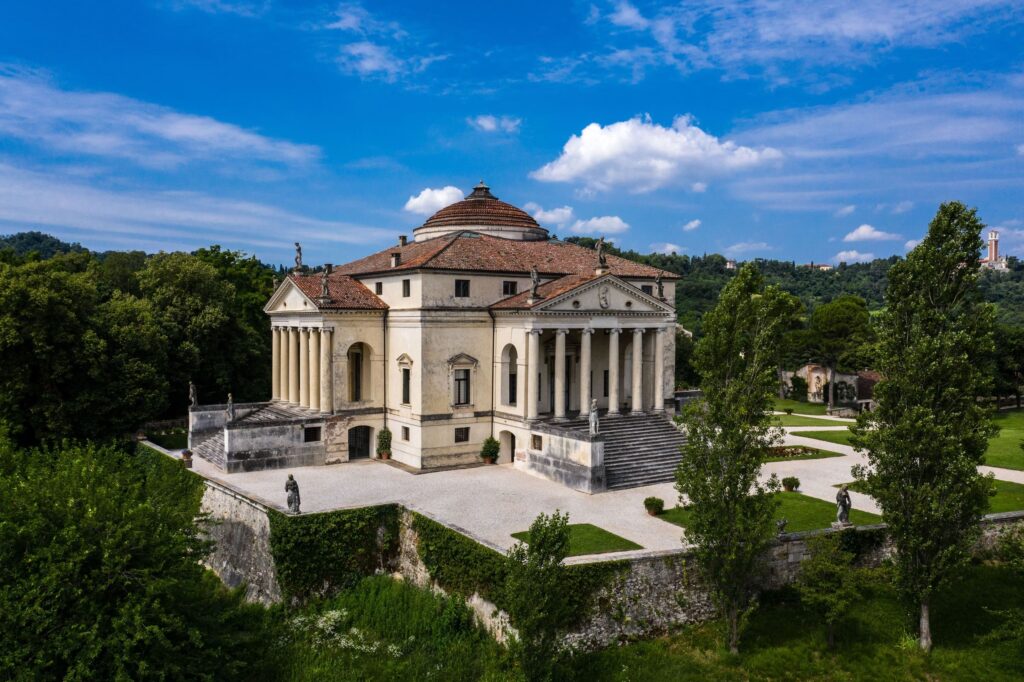The experience
The itinerary is “compact,” meaning it runs about 60 km from the center, not very tiring, and has the virtue of combining different locations and themes, helping the roots traveler both to recognize the signs of the past and to understand what lies behind the success of Made in Italy.
People live in Vicenza to learn about the genius of Palladio and the villas, but also to remember the pilgrimages to Our Lady of Monte Berico. We then move into the countryside area and toward the mountains, with cooking classes, visits to the historic town of Bassano, rural museums, and not forgetting the rivers that were so important in the past. Given the efficiency of the local archival system, a time to learn more about researching the records of one’s ancestors is also indicated.
The itinerary may be conducted in collaboration with the Vicentini nel mondo association, the Pro Loco and with the support of tourist information and reception offices.
Shortly
Tour
The historic center of Vicenza
The name of architect Andrea Palladio is known throughout the world and a boast for those of Italian descent. Walking through the streets of Vicenza’s historic center, one can find numerous vestiges of its architectural genius, such as the Basilica Palladiana and The Olympic Theater, built in the late 16th century with still exceptional solutions and techniques.
Address: Piazza dei Signori, 36100 Vicenza VI and Theatre: Piazza Matteotti, 11, 36100 Vicenza VI
The Venetian Villas in the surroundings
Also a short distance, about 20 km, from the historic center of the Berico capital we can admire numerous examples of the civilization of the Venetian villas, places that are a symbol of balance and architectural perfection, as well as land management. One of these, designed by Palladio, is Villa Almerico Capra, famous all over the world as “La Rotonda” and since 1994 a UNESCO World Heritage Site.
Nearby we also mention Villa Valmarana ai Nani, with its extraordinary cycle of frescoes by Giambattista and Giandomenico Tiepolo.
Address: Via della Rotonda, 45, 36100 Vicenza VI
Vicenza: the research
In Vicenza it is possible to satisfy the desire to know the roots of one’s family, reconstructing its history thanks to the consultation of the historical archives of the diocese, partly digitized with the “Canonical Books” project and preserved at the headquarters of the Diocesan Historical Archive.
Accompanied by our trusted genealogist, you will be able to search through baptismal registers, confirmation registers, marriage registers, death registers and soul records.
Address: Piazza del Duomo, 7, 36100 Vicenza VI
Devotion
The entire Veneto region has always been a land where its inhabitants are very attached to religion, prayer and devotion to saints. One of the major places of worship is the sanctuary of the Madonna of Monte Berico, which has become a place of pilgrimages and processions since the 15th century, ascending the mountain through architect Francesco Muttoni’s scenic porticoes.
Address:Viale Dieci Giugno, 87, 36100 Vicenza VI
The kitchen: taste and try
The afternoon will be relaxing with a visit to a farm located in the Berica countryside about 20 km from the capital city.
A slice of polenta and the typical Vicenza cured meat, sopressa DOP, will be tasted as a snack, and there will be a cooking class lasting a couple of hours involving the making of the typical local pasta, bigoli, made with the historic pasta press, and a “backyard” ragout, as per country custom.
Address: local farmhouse
The city centre and the Palladian Bridge
For Venetian culture, the Bassano Bridge, known as the Bridge of the Alpini, is a symbolic place.
Designed by Palladio, it saw painful events in World War I and World War II. Today it is also a place for tasting schnapps and other specialties.
The center of Bassano then with squares, palaces and taverns will allow for a relaxing walk, guided by members of the very active local Pro Loco.
From Bassano it is also possible to reach and discover the Pedemontana Veneta belt, Monte Grappa and the Brenta River.
For a walk, we choose the Brenta...the Grappa?
Rivers as well as communication routes can be experienced and known through innovative and fun sensory experiences. The Brenta, because of its conformation, allows root travelers to experience, with the guidance of experienced sportsmen, the thrill of a canoe descent or rafting, or a visit to the karst caves of Oliero.
It is worth mentioning that a unique event is held here in July, the Palio delle Zattere, a sports-historical-folkloric event, which, has a twofold characteristic: the “competition” on the swirling water of the Brenta between the teams of the different contrade, and the memory of the activities of the workers (Zattieri) who used to bring to Venice-via the course of the rivers-the timber from the forests of the Asiago plateau (or in the case of the Piave, from the forests of Cadore). It is a unique activity and gives an insight into the rural life of past centuries.
The Pro Loco of Valstagna can assist you with the itinerary and documentation.
Address: Oliero Caves, Via Oliero di Sotto, 85, 36029 Val Brenta VI
Asiago Plateau and the Seven Municipalities
About 25 km from Bassano you arrive in a characteristic area of the Venetian Prealps: the Asiago Plateau and the Seven Municipalities. The place, now devoted to tourism and cheese production, thanks to the presence of nearly one hundred mountain pastures, experienced “on the front lines” the destruction of the Great War. At that time, it gave rise to – in addition to traditional migration – the so-called “displacement,” with dispersion of the (Cimbrian-speaking) inhabitants to the Vicentine plains and throughout Italy.
Elements of historical rurality include the raising of sheep, which produced wool useful for the textile companies that developed in the foothills and enabled early local industrial development.
The guides of the Vicentini nel Mondo will accompany you on this historical walk, together with the local leaders of the Pro Loco
Address: via della Stazione 1 , Asiago
Lusiana and the Ethnographic Museum
The “Palazzon” house museum, home of the Association of the same name, of the Lusiana diffuse museum is a faithful and “loving” reproduction of the rural environments and traditions of the late 1800s and 1900s. In the museum tour, living and working environments have been philologically reconstructed, with tools of the time, which are interesting because they are also related to particular activities: spinning, meal preparation, and schooling. Also noteworthy is the care in keeping this exhibition alive and “telling” the visitor about it. It is definitely a “living museum.” A short distance away is the “valley of the mills”, which takes us back to the world of work of the past.
Address: Via VII Comuni, 12D, 36046 Lusiana VI
Let us guide you on your journey to the Roots
Don't miss the opportunity to explore the places that have shaped your origins, request a tailor-made itinerary without obligation


